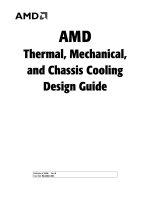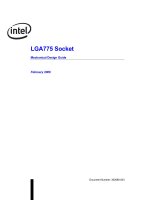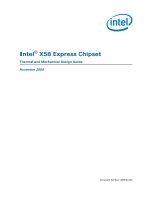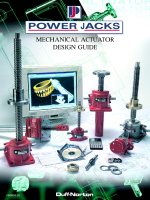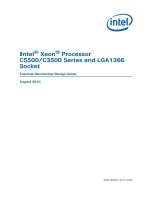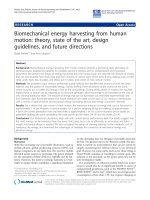Refrigerant piping design guide
Bạn đang xem bản rút gọn của tài liệu. Xem và tải ngay bản đầy đủ của tài liệu tại đây (1.88 MB, 91 trang )
Application Guide
Refrigerant Piping Design Guide
TX Valve Mounted
in Vertical Line
Sight Glass
Solenoid
Valve
Liquid Line
Distributor
External
Equalization Line
Slope In Direction Of
Refrigerant Flow
Bulb
Filter-Drier
Suction Line
Engineered for flexibility and performance.™
AG 31-011
Contents
Introduction..................................................................................................................3
Audience ............................................................................................................................................3
Using This Manual.............................................................................................................................3
Refrigerant Piping..............................................................................................................................4
Refrigerant Piping Design Check List ...............................................................................................5
Typical Refrigerant Piping Layouts .............................................................................6
Piping Design Basics ...................................................................................................9
Liquid Lines .....................................................................................................................................10
Suction Lines ...................................................................................................................................12
Discharge Lines ...............................................................................................................................13
Multiple Refrigeration Circuits ........................................................................................................16
Sizing Refrigerant Lines ............................................................................................18
Refrigerant Capacity Tables .............................................................................................................18
Equivalent Length for Refrigerant Lines .........................................................................................18
Refrigerant Oil .................................................................................................................................22
Suction Line Sizing..........................................................................................................................22
Oil Return in Suction and Discharge Risers ....................................................................................23
Thermal Expansion Valves ........................................................................................33
Hot Gas Bypass................................................................................................................................35
Hot Gas Bypass Valves ....................................................................................................................36
Installation Details .....................................................................................................40
Pump Down .....................................................................................................................................40
Piping Insulation ..............................................................................................................................40
Refrigerant Line Installation ............................................................................................................41
Low Ambient Operation ............................................................................................42
Fan Cycling and Fan Speed Control ................................................................................................42
Condenser Flood Back Design.........................................................................................................42
Safety and the Environment.......................................................................................44
Appendix 1 - Glossary ...............................................................................................45
Appendix 2 – Refrigerant Piping Tables (Inch-Pound) .............................................49
Appendix 3 – Refrigerant Piping Tables (SI) ............................................................70
THE INFORMATION CONTAINED WITHIN THIS GUIDE REPRESENTS THE OPINIONS
AND SUGGESTIONS OF McQUAY INTERNATIONAL.
EQUIPMENT, AND THE
APPLICATION OF THE EQUIPMENT AND SYSTEM SUGGESTIONS ARE OFFERED BY
McQUAY INTERNATIONAL AS SUGGESTIONS AND GUIDELINES ONLY, AND
McQUAY INTERNATIONAL DOES NOT ASSUME RESPONSIBILITY FOR THE
PERFORMANCE OF ANY SYSTEM AS A RESULT OF THESE SUGGESTIONS. THE
SYSTEM ENGINEER IS RESPONSIBLE FOR SYSTEM DESIGN AND PERFORMANCE.
2
Application Guide AG 31-011
Introduction
Audience
This Application Guide was created for design engineers and service technicians to demonstrate how
to size refrigerant piping.
Using This Guide
This Guide covers R-22, R-407C, R-410A, and R-134a used in commercial air conditioning
systems. It does not apply to industrial refrigeration and/or Variable Refrigerant Volume (VRV)
systems. Illustrations and figures are not to scale. Examples showing how to perform an analysis
appear in shaded outlined boxes.
How to Determine Equivalent Length
Calculate the equivalent length of the liquid line for the following condensing unit with DX
air-handling unit.
The liquid line is composed of the following elements:
• 30 ft (9.14 m) of 1-3/8 inch (35 mm) piping
• 4 long radius elbows
• 1 filter drier
• 1 sight glass
• 1 globe type isolating valve
To determine the equivalent length for the refrigerant accessories use Table 4 and Table 5
(page 50).
Item
Quantity
Dimension (ft)
Total (ft)
Long radius elbow
4
2.3 (0.7m)
9.2 (2.8m)
Filter drier
1
35 (10.7m)
35 (10.7m)
Sight glass
1
2.5 (0.76m)
2.5 (0.76m)
Globe valve
1
38 (11.6m)
38 (11.6m)
Piping
1
30 (9.1m)
30 (9.1m)
Total
Application Guide AG 31-011
117.7 (34.96m)
3
Refrigerant Piping
Several HVAC systems require field refrigeration piping to be designed and installed on-site.
Examples include:
•
Condensing units
•
Direct expansion (DX) coil in air handlers
•
Remote evaporators with air-cooled chillers (Figure 1)
•
Chiller with a remote air-cooled condensers
Figure 1 - Typical Field Piping Application
The information contained in this Application Guide is based on Chapter 2 of ASHRAE's
Refrigeration Handbook and McQuay's experience with this type of equipment.
A properly designed and installed refrigerant piping system should:
4
•
Provide adequate refrigerant flow to the evaporators, using practical refrigerant line sizes
that limit pressure drop
•
Avoid trapping excessive oil so that the compressor has enough oil to operate properly at all
times
•
Avoid liquid refrigerant slugging
•
Be clean and dry
Application Guide AG 31-011
Refrigerant Piping Design Check List
The first step in refrigerant piping design is to gather product and jobsite information. A checklist
for each is provided below. How this information is used will be explained throughout the rest of
this guide.
Product Information
•
Model number of unit components (condensing section, evaporator, etc.)
•
Maximum capacity per refrigeration circuit
•
Minimum capacity per refrigeration circuit
•
Unit operating charge
•
Unit pump down capacity
•
Refrigerant type
•
Unit options (Hot Gas Bypass, etc.)
•
Does equipment include isolation valves and charging ports
•
Does the unit have pump down?
Jobsite Information
•
Sketch of how piping will be run, including:
o
Distances
o
Elevation changes
o
Equipment layout
o
Fittings
o
Specific details for evaporator piping connections
•
Ambient conditions where piping will be run
•
Ambient operating range (will the system operate during the winter?)
•
Type of cooling load (comfort or process)
•
Unit isolation (spring isolators, rubber-in-shear, etc.)
☺Tip: Use this list to gather the information required to design your refrigerant piping
system
Application Guide AG 31-011
5
Typical Refrigerant Piping Layouts
This section shows several typical refrigerant piping layouts for commercial air conditioning. They
will be used throughout this guide to illustrate piping design requirements.
Figure 2 shows a condensing unit mounted on grade connected to a DX coil installed in a roofmounted air-handling unit.
1.
A liquid line supplies liquid refrigerant from the condenser to a thermal expansion (TX)
valve adjacent to the coil.
2.
A suction line provides refrigerant gas to the suction connection of the compressor.
Figure 2 – Condensing Unit with DX Air Handling Unit
TX Valve
DX Air
Handling Unit
Suction Riser
Inverted Trap
Not Required
With
Air Cooled
Pumpdown
Sight Glass
Condensing Unit
Suction Line
Solenoid
Valve
Filter-Drier
Liquid
Line
6
Application Guide AG 31-011
Figure 3 shows a roof-mounted air-cooled chiller with a remote evaporator inside the building.
1.
There are two refrigeration circuits, each with a liquid line supplying liquid refrigerant
from the condenser to a TX valve adjacent to the evaporator, and a suction line returning
refrigerant gas from the evaporator to the suction connections of the compressor.
2.
There is a double suction riser on one of the circuits. Double suction risers are covered in
more detail in the Oil Return in Suction and Discharge Risers section of this guide (page
23).
1
Figure 3 - Air-cooled Chiller with Remote Evaporator
Air Cooled Chiller
Remote
With Remote
Evaporator
Evaporator
Liquid Line
Liquid Line Riser
Suction Line Riser
TX Valve
Double
Sight Glass
Suction Riser
Solenoid Valve
Filter-Drier
Application Guide AG 31-011
7
Figure 4 shows an indoor chiller with a remote air-cooled condenser on the roof.
1.
The discharge gas line runs from the discharge side of the compressor to the inlet of the
condenser.
2.
The liquid line connects the outlet of the condenser to a TX valve at the evaporator.
3.
The hot gas bypass line on the circuit runs from the discharge line of the compressor to the
liquid line connection at the evaporator.
Figure 4 - Indoor Chiller with Remote Air-cooled Condenser
Air Cooled
Condenser
Discharge Line Inverted
Trap (Can be Replaced With
Check Valve)
Discharge Line
Liquid Line Riser
Discharge Riser
Trap Only At Base
Hot Gas Bypass
Top Connection To
Avoid Liquid
Refrigerant Collection
Chiller
Sight Glass
TX Valve
Solenoid Valve
Filter-Drier
8
Application Guide AG 31-011
Piping Design Basics
Good piping design results in a balance between the initial cost, pressure drop, and system
reliability. The initial cost is impacted by the diameter and layout of the piping. The pressure drop
in the piping must be minimized to avoid adversely affecting performance and capacity. Because
almost all field-piped systems have compressor oil passing through the refrigeration circuit and back
to the compressor, a minimum velocity must be maintained in the piping so that sufficient oil is
returned to the compressor sump at full and part load conditions. A good rule of thumb is a
minimum of:
•
500 feet per minute (fpm) or 2.54 meters per second (mps) for horizontal suction and hot
gas lines
•
1000 fpm (5.08 mps) for suction and hot gas risers
•
Less than 300 fpm (1.54 mps) to avoid liquid hammering from occurring when the solenoid
closes on liquid lines
Hard drawn copper tubing is used for halocarbon refrigeration systems. Types L and K are approved
for air conditioning and refrigeration (ACR) applications. Type M is not used because the wall is
too thin. The nominal size is based on the outside diameter (OD). Typical sizes include 5/8 inch,
7/8 inch, 1-1/8 inch, etc.
Figure 5 - Refrigerant Grade Copper Tubing
Copper tubing intended for ACR applications is
dehydrated, charged with nitrogen, and plugged
by the manufacturer (see Figure 5).
Formed fittings, such as elbows and tees, are
used with the hard drawn copper tubing. All
joints are brazed with oxy-acetylene torches by
a qualified technician.
As mentioned before, refrigerant line sizes are
selected to balance pressure drop with initial
cost, in this case of the copper tubing while also
maintaining enough refrigerant velocity to carry
oil back to the compressor.
Pressure drops are calculated by adding the
length of tubing required to the equivalent feet (meters) of all fittings in the line. This is then
converted to PSI (kPa).
Application Guide AG 31-011
9
Pressure Drop and Temperature Change
As refrigerant flows through pipes the pressure drops and changes the refrigerant saturation
temperature. Decreases in both pressure and saturation temperature adversely affect compressor
performance. Proper refrigeration system design attempts to minimize this change to less than 2°F
(1.1°C) per line. Therefore, it is common to hear pressure drop referred to as “2°F” versus PSI
(kPa) when matching refrigeration system components.
For example, a condensing unit may produce 25 tons (87.9 kW) of cooling at 45°F (7.2°C) saturated
suction temperature. Assuming a 2°F (1.1°C) line loss, the evaporator would have to be sized to
deliver 25 tons (87.9 kW) cooling at 47°F (7.2°C) saturated suction temperature.
Table 1 compares pressure drops in temperatures and pressures for several common refrigerants.
Note that the refrigerants have different pressure drops for the same change in temperature. For
example, many documents refer to acceptable pressure drop being 2°F (1.1°C) or about 3 PSI (20.7
kPa) for R-22. The same 3 PSI change in R-410A, results in a 1.2°F (0.7°C) change in temperature.
Table 1- Temperature versus Pressure Drop
Refrigerant
Suction
Discharge
Liquid
Pressure Drop
Pressure Drop
Pressure Drop
°F (°C)
PSI (kPa)
°F (°C)
PSI (kPa)
°F (°C)
PSI (kPa)
2 (1.1)
2.91 (20.1)
1 (0.56)
3.05 (21.0)
1 (0.56)
3.05 (21.0)
R-407C
2 (1.1)
2.92 (20.1)
1 (0.56)
3.3 (22.8)
1 (0.56)
3.5 (24.1)
R-410A
2 (1.1)
4.5 (31.0)
1 (0.56)
4.75 (32.8)
1 (0.56)
4.75 (32.8)
R-134a
2 (1.1)
1.93 (13.3)
1 (0.56)
2.2 (15.2)
1 (0.56)
2.2 (15.2)
R-22
Note Suction and discharge pressure drops based on 100 equivalent feet (30.5 m) and 40°F (4.4°C) saturated
temperature.
Liquid Lines
Liquid lines connect the condenser to the evaporator and carry liquid refrigerant to the TX valve. If
the refrigerant in the liquid line flashes to a gas because the pressure drops too low or because of an
increase in elevation, then the refrigeration system will operate poorly. Liquid sub-cooling is the
only method that prevents refrigerant flashing to gas due to pressure drops in the line.
The actual line size should provide no more than a 2 to 3°F (1.1 to 1.7°C) pressure drop. The actual
pressure drop in PSI (kPa) will depend on the refrigerant.
Oversizing liquid lines is discouraged because it will significantly increase the system refrigerant
charge. This, in turn, affects the oil charge.
Figure 2 (page 6) shows the condenser below the evaporator. As the liquid refrigerant is lifted from
the condenser to the evaporator, the refrigerant pressure is lowered. Different refrigerants will have
different pressure changes based on elevation. Refer Table 2 to for specific refrigerants. The total
pressure drop in the liquid line is the sum of the friction loss, plus the weight of the liquid refrigerant
column in the riser.
Table 2 - Pressure Drop In Liquid Lines By Refrigerant 1
Refrigerant
R-22
R-407C
R-410A
R-134a
Pressure Drop PSI/ft (kPa/m) Riser
0.50 (11.31)
0.47 (10.63)
0.43 (9.73)
0.50 (11.31)
Only sub-cooled liquid refrigerant will avoid flashing at the TX valve in this situation. If the
condenser had been installed above the evaporator, the pressure increase from the weight of the
liquid refrigerant in the line would have prevented the refrigerant from flashing in a properly sized
line without sub-cooling.
1
10
Based on saturated liquid refrigerant at 100°F (37.7°C)
Application Guide AG 31-011
It is important to have some sub-cooling at the TX valve so that the valve will operate properly and
not fail prematurely. Follow the manufacturer’s recommendations. If none are available, then
provide 4 to 6°F (2.2 to 3.3°C) of sub-cooling at the TX valve.
Liquid lines require several refrigerant line components and/or accessories to be field selected and
installed (Figure 6). Isolation valves and charging ports are required. Generally, it is desirable to
have isolation valves for servicing the basic system components, such as a condensing unit or
condenser. In many cases, manufacturers supply isolating valves with their product, so be sure to
check what is included. Isolating valves come in several types and shapes.
Figure 6 - Refrigerant Accessories 2
Aux Side
Distributor
Sight Glass
Connector
Solenoid Valve
TX Valve
Filter-Drier
Referring to Figure 2 (page 6):
1.
Working from the condenser, there is a liquid line filter-drier. The filter drier removes
debris from the liquid refrigerant and contains a desiccant to absorb moisture in the system.
Filter driers are either disposable or a permanent with replaceable cores.
2.
Next there is a sight glass that allows technicians to view the condition of the refrigerant in
the liquid line. Many sight glasses include a moisture indicator that changes color if
moisture is present in the refrigerant.
3.
Following the sight glass is the TX valve. (More information about TX valves is available
under Thermal Expansion Valves, page 33.)
Possible accessories for this system include:
•
A hot gas bypass port. This is a specialty fitting that integrates with the distributor – an
auxiliary side connector (ASC).
•
A pump down solenoid valve. If a pump down is utilized, the solenoid valve will be
located just before the TX valve, as close to the evaporator as possible.
•
Receivers in the liquid line. These are used to store excess refrigerant for either pump
down or service (if the condenser has inadequate volume to hold the system charge), or as
part of a flooded low ambient control approach (More information about flooded low
ambient control approach is available under Condenser Flood Back Design, page 42).
Receivers are usually avoided because they remove sub-cooling from the condenser,
increase the initial cost, and increase the refrigerant charge.
Liquid lines should be sloped 1/8 inch per foot (10.4 mm/m) in the direction of refrigerant flow.
Trapping is unnecessary.
2
Photos courtesy of Sporlan Division – Parker Hannifin Corporation
Application Guide AG 31-011
11
Suction Lines
Suction gas lines allow refrigerant gas from the evaporator to flow into the inlet of the compressor.
Undersizing the suction line reduces compressor capacity by forcing it to operate at a lower suction
pressure to maintain the desired evaporator temperature. Oversizing the suction line increases initial
project costs and may result in insufficient refrigerant gas velocity to move oil from the evaporator
to the compressor. This is particularly important when vertical suction risers are used. (More
information about designing vertical suction risers is covered in more detail in Suction Line Sizing,
page 22)
Suction lines should be sized for a maximum of 2 to 3°F (1.1 to 1.7°C) pressure loss. The actual
pressure drop in PSI (kPa) will depend on the refrigerant.
Suction Line Piping Details
While operating, the suction line is filled with superheated refrigerant vapor and oil. The oil flows
on the bottom of the pipe and is moved along by the refrigerant gas flowing above it. When the
system stops, the refrigerant may condense in the pipe depending on the ambient conditions. This
may result in slugging if the liquid refrigerant is drawn into the compressor when the system restarts.
To promote good oil return, suction lines should be pitched 1/8 inch per foot (10.4 mm/m) in the
direction of refrigerant flow. Evaporator connections require special care because the evaporator has
the potential to contain a large volume of condensed refrigerant during off cycles. To minimize
slugging of condensed refrigerant, the evaporators should be isolated from the suction line with an
inverted trap as shown in Figure 7 and Figure 8:
The trap should extend above the top of the evaporator before leading to the compressor.
12
1.
With multiple evaporators, the suction piping should be designed so that the pressure drops
are equal and the refrigerant and oil from one coil cannot flow into another coil.
2.
Traps may be used at the bottom of risers to catch condensed refrigerant before it flows to
the compressor. Intermediate traps are unnecessary in a properly sized riser as they
contribute to pressure drop.
3.
Usually with commercially produced air conditioning equipment, the compressors are “prepiped” to a common connection on the side of the unit.
4.
Suction line filter driers are available to help clean the refrigerant before it enters the
compressor. Because they represent a significant pressure drop, they should only be added
if circumstances require them, such as after compressor burnout. In this instance, the
suction filter drier is often removed after the break-in period for the replacement
compressor. Suction filter driers catch significant amounts of oil, so they should be
installed per the manufacturer’s specifications to promote oil drainage.
Application Guide AG 31-011
Figure 7 - Remote Evaporator Piping Detail
Slope In Direction of
Refrigerant Flow
Inverted Trap Only
Required If There Are
Evaporators Upstream
Trap to Protect TX
Valve Bulb From
Liquid Refrigerant
Figure 8 - Suction Piping Details
Compressor Above Coil
Slope In Direction Of
Refrigerant Flow
Trap to Protect TX
Valve Bulb From
Liquid refrigerant
Compressor
Above Coil
No Inverted Trap
Required If
Properly Sloped
Trap Above Coil Height
Not required with
Compressor
Pumpdown Systems
Below Coil
Slope In
Direction Of
Refrigerant Flow
Trap to Protect TX
Valve Bulb From Liquid
Refrigerant
Slope In Direction Of
Refrigerant Flow
Application Guide AG 31-011
Compressor Below Coil
13
Discharge Lines
Discharge gas lines (often referred to as hot gas lines) allow refrigerant to flow from the discharge of
the compressor to the inlet of the condenser. Undersizing discharge lines will reduce compressor
capacity and increase compressor work. Over sizing discharge lines increases the initial cost of the
project and may result in insufficient refrigerant gas velocity to carry oil back to the compressor.
Discharge lines should be sized for no more than 2 to 3°F (1.1 to 1.7°C) pressure loss. The actual
pressure drop in PSI will depend upon the refrigerant. Figure 9 illustrates how capacity and power
consumption are affected by increasing pressure drop for both discharge and suction lines. Although
these curves are based on an R-22 system, similar affects occur with other refrigerants.
Figure 9-Capacity and Performances versus Pressure Drop
Approx. Effect of Gas Line Pressure Drops on R-22 Compressor Capacity & Power – Suction Line
110
108
106
Power
104
%
102
100
98
Capacity
96
94
92
0
0.5
1
1.5
2
2.5
3
3.5
4
Line Loss, oF
Approx. Effect of Gas Line Pressure Drops on R-22 Compressor Capacity & Power – Discharge Line
108
106
104
%
Power
102
100
Capacity
98
96
0
0.5
1
1.5
2
2.5
3
3.5
4
Line Loss, oF
14
Application Guide AG 31-011
Discharge Line Piping Details
Discharge lines carry both refrigerant vapor and oil. Since refrigerant may condense during the off
cycle, the piping should be designed to avoid liquid refrigerant and oil from flowing back into the
compressor. Traps can be added to the bottom of risers to catch oil and condensed refrigerant during
off cycles, before it flows backward into the compressor. Intermediate traps in the risers are
unnecessary in a properly sized riser as they increase the pressure drop. Discharge lines should be
pitched 1/8 inch per foot (10.4 mm/m) in the direction of refrigerant flow towards the condenser
(Figure 10).
Whenever a condenser is located above the compressor, an inverted trap or check valve should be
installed at the condenser inlet to prevent liquid refrigerant from flowing backwards into the
compressor during off cycles. In some cases (i.e. with reciprocating compressors), a discharge
muffler is installed in the discharge line to minimize pulsations (that cause vibration). Oil is easily
trapped in a discharge muffler, so it should be placed in the horizontal or downflow portion of the
piping, as close to the compressor as possible.
Figure 10 - Discharge Line Piping Details
Slope In Direction Of
Refrigerant Flow
Trap at Bottom of Riser
Keep Small as Possible
Application Guide AG 31-011
15
Multiple Refrigeration Circuits
For control and redundancy, many refrigeration systems include two or more refrigeration circuits.
Each circuit must be kept separate and designed as if it were a single system. In some cases, a single
refrigeration circuit serves multiple evaporators, but multiple refrigeration circuits should never be
connected to a single evaporator. A common mistake is to install a two circuit condensing units
with a single circuit evaporator coil.
Figure 11 shows common DX coils that include multiple circuits. Interlaced is the most common.
It is possible to have individual coils, each with a single circuit, installed in the same system and
connected to a dedicated refrigeration circuit.
Figure 11 - DX Coils with Multiple Circuits
While most common air conditioning applications have one evaporator for each circuit, it is possible
to connect multiple evaporators to a single refrigeration circuit.
Figure 12 shows a single refrigeration circuit serving two DX coils. Note that each coil has its own
solenoid and thermal expansion valve. There should be one TX valve for each distributor.
Individual solenoids should be used if the evaporators will be operated independently (i.e. for
capacity control). If both evaporators will operate at the same time, then a single solenoid valve in a
common pipe may be used.
16
Application Guide AG 31-011
Figure 12 - Multiple Evaporators on a Common Refrigeration Circuit
Filter-Drier
Liquid Line
Solenoid Valve
Sight Glass
TX Valve
Suction Line
External
Equalization
Line
Bulb mounted on Horizontal
Pipe, Close to Coil
Avoid Mounting in Traps
Slope In Direction Of
Refrigerant Flow
Trap to Protect TX
Valve Bulb From Liquid
Refrigerant
Application Guide AG 31-011
17
Sizing Refrigerant Lines
Refrigerant Capacity Tables
Appendix 2 (page 49) and Appendix 3 (page 70) provide refrigerant line sizes for commonly used
refrigerants. There is data for suction, discharge, and liquid lines. Suction and discharge lines have
data for 0.5, 1, and 2°F (0.28, 0.56, and 1.7°C) changes in saturated suction temperature (SST).
Liquid lines are based on 1°F (0.56°C) changes in saturation temperature.
The data is based on 105°F (40.6°C) condensing temperature (common for water-cooled equipment)
and must be corrected for other condensing temperatures (air-cooled equipment is typically 120 to
125°F (48.9 to 51.7°C)). The tables are also based on 100 feet (30.5 m) of equivalent length. The
actual pressure drop is estimated based on the actual equivalent length of the application using
equations in the footnotes of the refrigerant capacity tables.
☺Tip: Saturated suction temperature is based upon the pressure leaving the evaporator
and represents the refrigerant temperature as a gas without superheat. The actual
refrigerant temperature leaving the evaporator will be higher than this. The difference
between the two temperatures is called superheat.
Equivalent Length for Refrigerant Lines
Table 4 and Table 5 in Appendix 2 (page 50) provide information for estimating equivalent lengths.
The actual equivalent length is estimated by calculating the path length in feet (meters) that the
piping will follow and adding the pressure drops of the fittings and/or accessories along that length.
The tables provide pressure drops in equivalent feet of straight pipe for fittings and accessories.
For example, in Table 4, we see that a 7/8-inch (22 mm) long radius elbow has a pressure drop
equivalent to 1.4 feet (0.43 m) of straight copper pipe.
18
Application Guide AG 31-011
How to Determine Equivalent Length
Calculate the equivalent length of the liquid line for the following condensing unit with DX
air-handling unit:
Liquid Line
The liquid line is composed of the following elements:
• 22 ft (6.7 m) of 1-3/8 inch (35 mm) piping
• 7 long radius elbows
• 1 filter drier
• 1 sight glass
• 1 globe type isolating valve
To determine the equivalent length for the refrigerant accessories use Table 4 and Table 5
(page 50).
Item
Dimension (ft)
Total (ft)
Long radius elbow
7
2.3 (0.70m)
16.1 (4.90m)
Filter drier
1
35 (10.70m)
35 (10.70m)
Sight glass
1
2.5 (0.76m)
2.5 (0.76m)
Globe valve
1
38 (11.58m)
38 (11.58m)
Piping
1
22 (6.70m)
22 (6.70m)
Total
Application Guide AG 31-011
Quantity
113.6 (34.64m)
19
How to Size Liquid Lines
Size the refrigerant liquid lines and determine the sub-cooling required to avoid flashing at
the TX valve for the condensing unit with DX air-handling unit shown in the previous
example.
The system:
• Uses R-410A
• Has copper pipes
• Evaporator operates at 40˚F (4.4˚C)
• Condenser operates at 120˚F (48.9˚C)
• Capacity is 60 tons (211 kW)
• Liquid line equivalent is 113.6 ft (34.64 m)
• Has a 20 ft (6.1 m) riser with the evaporator above the condenser
Step 1 – Estimate Pipe Size
To determine the liquid line pipe size for a 60 ton unit, use Table 8 in Appendix 2.
According to the table, a 1-3/8 inch (35 mm) pipe will work for a 79.7 ton (280 kW) unit.
Note, the table conditions (equivalent length and condensing temperature) are different
than the design conditions.
Step 2 – Calculate Actual ΔT
Using Note 5 in the table, we can calculate the saturation temperature difference based
upon the design conditions:
ΔTActual
⎡ Actual length ⎤ ⎡ Actual capacity ⎤
= ΔTTable ⎢
⎥⎢
⎥
⎣ Table length ⎦ ⎣ Table capacity ⎦
⎡ 113.6 ft ⎤ ⎡ 60 tons ⎤
ΔTActual = 1°F ⎢
⎥⎢
⎥
⎣ 100 ft ⎦ ⎣ 79.7 tons ⎦
1.8
1.8
= 0.68o F
1.8
⎛
⎞
⎡ 34.64m ⎤ ⎡ 211kW ⎤
= 0.39o C ⎟
⎜ ΔTActual = 0.56°C ⎢
⎥
⎢
⎥
⎜
⎟
⎣ 30.48m ⎦ ⎣ 280kW ⎦
⎝
⎠
Step 3 – Calculate Actual Piping Pressure Drop
According to Table 8, the pressure drop for 1˚F (0.56oC) saturation temperature drop with
a 100 ft equivalent length is 4.75 PSI (32.75 kPa).
The actual piping pressure drop is determined using the equation
⎛ ΔTActual ⎞
⎟⎟
Pressure Drop Actual = Pressure Drop Table ⎜⎜
T
Δ
Table ⎠
⎝
⎛ 0.68o F ⎞
Pressure Drop Actual = 4.75PSI ⎜ o
⎟ = 3.23 PSI
⎝ 1F ⎠
⎛
⎞
⎛ 0.39 o C ⎞
⎜ Pressure Drop Actual = 32.75 kPa ⎜
⎟
⎟
kPa
=
22
.
81
⎜ 0.56 o C ⎟
⎜
⎟
⎝
⎠
⎝
⎠
Step 4 – Calculate Total Pressure Drop
20
Application Guide AG 31-011
Next to determine the Total pressure drop, we use Table 2 (page 10), and recall that the
riser is 20 ft. For R-410A the pressure drop is 0.43 PSI per ft (9.73 kPa/m).
Refrigerant pressure drop
ft
0.43 PSI
Pressure drop from the riser = 20 ft ×
= 8.6 PSI
ft
Pressure drop from the riser = Riser height ×
9.73kPa
⎞
⎛
= 59.35 kPa ⎟
⎜ Pressure drop from the riser = 6.1m ×
m
⎠
⎝
Total pressure drop = Actual pressure drop + Riser pressure drop
Total pressure drop = 3.23 PSI + 8.6 PSI = 11.83 PSI
(Total pressure drop = 59.35 kPa + 22.81 kPa = 82.16 kPa )
Step 5 – Determine the Saturated Pressure of R-410A at the TX Valve
Using refrigerant property tables which can be found in Appendix 2 of McQuay’s
Refrigerant Application Guide (AG 31-007, see www.mcquay.com) the saturated
pressure for R-410A at 120˚F is 433 PSIA (absolute) (2985 kPaA). To calculate the
saturation pressure at the TX valve, we take the saturated pressure of R-410A at 120˚F
and subtract the total pressure drop.
Saturated Pressure
TX Valve
= Saturated pressure120F − Total pressure drop
Saturated pressureTX Valve = 433 PSIA − 11.83 PSIA = 421.17PSIA
(Saturated pressure TX Valve = 2985 kPa − 82.15 kPa = 2902.85 kPa )
Step 6 – Determine the Saturation Temperature at the TX Valve
Referring back to the Refrigeration property Tables in Application Guide 31-007, the
saturation temperature at the TX valve can be interpolated using the saturation pressure
at the TX valve (421 PSIA). The saturation temperature at the TX valve is found to be
117.8˚F
Step 7- Determine The Sub-cooling Required for Saturated Liquid at the TX Valve
The sub-cooling require to have saturated liquid at the TX valve can be found by:
Subcooling = Actual saturation temperature − saturation temperature TX Valve
Subcooling = 120 o F − 117.8 o F = 2.2 o F
Step 8- Determine the Required Sub-cooling for Proper Operation
2.2˚F is the amount of sub-cooling required to have saturated liquid refrigerant at the TX
valve. Anything less, and the refrigerant will start to flash and the TX valve will not
operate properly. For TX valves to operate properly and avoid diaphragm fluttering, there
should be an additional 4˚F of sub-cooling at the TX Valve.
Subcooling requirement = TX valve temperature + Minimum system temperature
Subcooling requirement = 2.2 o F + 4 o F = 6.2 o F
Application Guide AG 31-011
21
Refrigerant Oil
In the DX refrigeration systems covered by this guide, some amount of compressor lubricating oil
travels with the refrigerant throughout the piping system. The system design must promote oil
return or the compressor sump will run dry and damage the compressor.
Recall, refrigerant piping should be pitched to promote adequate oil return. Fittings and piping
layout that traps and retains oil must be avoided. Compressor capacity reduction contributes to the
challenge of designing the system.
For example, a screw compressor may reduce refrigerant flow (unload) down to 25%. At this
reduced refrigerant flow rate, the refrigerant velocity is reduced to the point that the oil may not be
pushed through the piping system and back to the compressor.
Examples of compressors that unload include:
•
Scroll compressors often have multiple compressors on a common refrigeration circuit.
The circuit can unload to the smallest compressor size. For example, 4 equally sized
compressors can unload down to 25%.
•
Individual reciprocating compressors unload down to as low as 33%.
multiple compressors on a common circuit allowing even more unloading.
•
Screw compressors may unload down to 25%.
There can be
Always check the manufacturer’s information to determine circuit unloading.
More piping typically requires more oil. This is particularly true for long liquid lines. Residential
split systems are often pre-charged at the factory with enough oil and refrigerant for a specified line
distance. When that distance is exceeded, additional refrigerant and oil will be required. For
commercial split systems, the equipment may come pre-charged or it may be provided with either
nitrogen or a small holding charge. The refrigerant and oil charge is then provided in the field.
To confirm if more oil is required, the system refrigerant charge must be calculated. Table 18 (page
60) through Table 21 (page 61) provide the charge per 100 feet (30.5 m) length for various
refrigerants. Generally, the oil charge should be 2 to 3% of the liquid line charge. Consult the
manufacturer for the correct volume of oil in the system and the amount of oil shipped in the
compressor sump. The required oil that needs to be added is the calculated total oil requirement less
the oil shipped in the equipment.
Required oil = Total oil required − oil shipped in equipment
HFC refrigerants use synthetic POE oils. These oils cannot be mixed with mineral oils. Refer to the
manufacturer’s instructions for the correct type of oil to use.
Suction Line Sizing
Suction lines contain gaseous refrigerant that moves oil along the piping and back to the compressor.
Over-sizing suction pipes increases the initial costs and may reduce the refrigerant gas velocity to
the point where oil is not returned to the compressor. Recall, under-sizing suction pipes reduces
system capacity. Oil movement is also impacted negatively by risers, because gravity prevents oil
from returning to the compressor.
22
Application Guide AG 31-011
Oil Return in Suction and Discharge Risers
Table 10 (page 55) through Table 17 (page 59) show minimum capacity oil return for suction and
discharge risers. When unloading capability exists, risers should be checked to verify that the
minimum capacity allows for acceptable oil return. For air conditioning applications that contain
less than 100 feet (30.5 m) of piping and no more than 33% capacity reduction per circuit, a properly
sized riser should be found. It may be necessary to use a smaller pipe diameter for the riser, which
creates a higher than desired pressure drop at full capacity, for optimal oil movement. To
compensate, a larger diameter pipe may be used for horizontal runs to minimize the total pressure
drop.
☺Tip: For most air conditioning applications, a single pipe riser will work. In this case, it
may be necessary to undersize the riser pipe by one pipe size to provide better oil
management.
Figure 13 - Proper Reduction Fittings for Risers
Install Expander in
Horizontal Pipe
Figure 13 shows the proper method for
reducing the pipe diameter for suction
and discharge risers. This approach will
prevent oil from being trapped in the
horizontal portion of the pipe.
Install Reducers In
Vertical Pipe
Application Guide AG 31-011
23
Figure 14 - Double Suction Riser Detail
Small Diameter Pipe Inverted Trap
Not Required If Pipe Properly Sloped
Small Diameter
Riser
Slope In Direction Of
Refrigerant Flow
Large Diameter
Riser
Minimize Trap Volume
Figure 14 shows a double suction riser arrangement that is more common in refrigeration
applications where suction pressure drops are more critical. Most modern air conditioning
applications can be met without requiring a double suction riser. Although the operation and design
of a double suction riser is included in this guide, it is strongly recommended that systems be
designed without a double suction riser, even if the pressure drop in the suction or discharge line is
higher than desired.
In a double suction riser at full capacity, the refrigerant flow passes through both risers with enough
velocity to move the oil. At minimum capacity, oil in the riser flows backward and fills the trap at
the bottom. Once the trap is full of oil, refrigerant flow through the large diameter riser is cut off
and only refrigerant gas flows through the smaller diameter riser. The sum of the two risers is sized
for full capacity. The smaller diameter riser is sized for minimum capacity.
One of the challenges of double suction risers is that they hold a significant amount of oil within the
trap. Refrigeration compressors often have larger sumps than commercial compressors, so the oil
lost to the trap is less problematic for refrigeration than commercial compressors. In addition, when
the capacity increases in a double suction riser, a large amount of oil is “blown” through the piping
system back to the compressor. Either an oil separator or a suction accumulator (both common in
refrigeration systems) may be required for a double suction riser to operate properly without causing
damage to the compressor.
24
Application Guide AG 31-011
How to Size Suction Lines
Size the suction line with a single pipe riser and determine the pressure drop for the
following air-cooled chiller with remote evaporator:
Single Pipe
Suction Riser
The system:
• Uses R-134a
• Has type L copper pipe
• Evaporator operates at 40˚F (4.4˚C) Saturated Suction Temperature (SST)
• Superheat is 10˚F (5.6˚C)
• Condenser operates at 120˚F (48.9˚C)
• Capacity is two 50 tons (176 kW) circuits with up to 20% turn down
• Suction line equivalent length for the horizontal runs is:
o Bottom 10 ft (30m)
o Top 12 ft (3.7m)
• Suction line equivalent length for a single pipe riser is 42 ft (12.8m)
Step 1- Estimate Suction Line Size
To determine the correct suction line size to operate the system at minimum capacity with a
single pipe riser use Table 7 in Appendix 2. According to the table, a 3-1/8 inch (79mm)
pipe will work for 57.1 tons (200.8kW) unit. Note, the table conditions (equivalent length
and condensing temperature) are different than the design conditions.
Step 2 – Correct for Actual Operating Conditions
Sizing the pipe for full load requires a correction for the 120˚F actual condenser
temperature. Referring to the correction factors at the bottom of Table 7;
Actual capacity = Table capacity × 0.902
Actual capacity = 57.1tons × 0.902 = 51.5 tons
Application Guide AG 31-011
25

